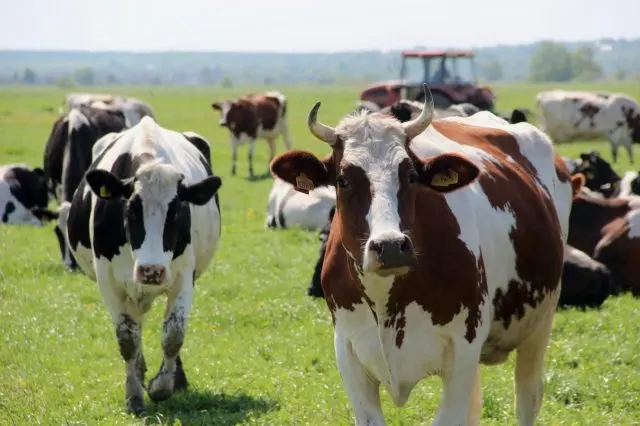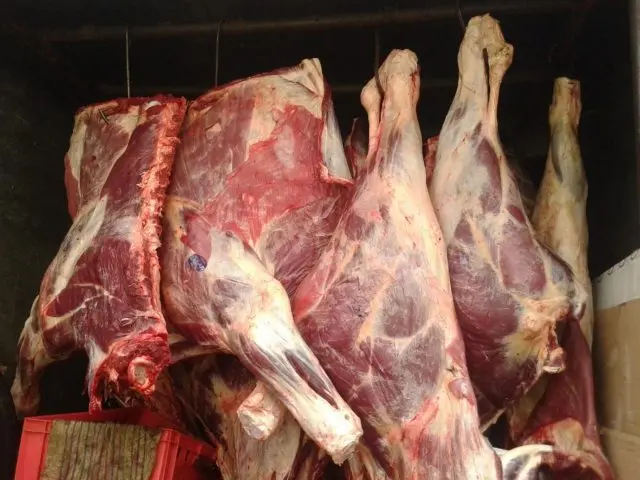Contents
The table of cattle meat yield from live weight allows you to understand how much meat you can count on under certain conditions. It is useful for novice breeders to learn about the factors that affect the final amount of production, the possibility of increasing it, and, conversely, to understand what contributes to a decrease in the yield of cattle meat.

What is slaughter weight and slaughter yield
Often characterizing the productivity of cattle, the term “slaughter yield of meat” is used. For many novice breeders, this concept is a real mystery, since not everyone knows what exactly such terminology means. In fact, this concept is due to specific meanings and a clear formulation. Slaughter weight can be different, which is influenced by the breed and type of pet.
To calculate the parameter, it is necessary to understand one more term – “slaughter weight of an animal”. It is a mistake to assume that this value is equal to the mass of a live bull or calf, since a number of body parts are removed from cattle after slaughter:
- lower legs;
- head;
- leather;
- internal organs;
- intestine.
After cutting the carcass and removing the listed parts, the slaughter weight of the animal is determined.
After that, you can begin to calculate the slaughter yield of meat, remembering that this concept is also related to the live weight of cattle (the bull is weighed before slaughter) and is indicated as a percentage.
The following factors have a direct influence on the yield of products:
- breed productivity direction – cows bred to obtain large milk yields have a mediocre yield of meat products, and animals bred as meat, on the contrary, cannot give high milk yield, but their meat yield and quality are many times higher;
- floor – males are always larger and better developed than cows, therefore the amount of meat they get is higher;
- age – the younger the representative of cattle, the less the desired result of the production, the same applies to old individuals, which for the most part begin to gain a layer of adipose tissue after a year and a half;
- physiological state – the healthier the cattle, the faster and better it gains mass.

Table of slaughter yield of cattle meat
Since the live weight of cattle and the final yield of meat are interrelated, it is necessary to know some standard indicators. Each breed has its own characteristics, but all representatives of cattle have one thing in common – the muscles grow in bulls only up to 18 months, then a layer of adipose tissue begins to grow in their place. Therefore, in animal husbandry, bulls are most often grown for slaughter only up to a year and a half.
Average values of slaughter and quality of meat products of different breeds of bulls at the age of one and a half years. The table shows the average statistical indicators that you should rely on when choosing a particular breed.
Breed | red mottled | Kazakh white-headed | black-and-white | Red steppe | Kalmyk | Simmental |
Live weight on the farm | 487,1 kg | 464,8 kg | 462,7 kg | 451,1 kg | 419,6 kg | 522,6 kg |
Weight at the meat packing plant | 479,8 kg | 455,1 kg | 454,4 kg | 442,4 kg | 407,9 kg | 514,3 kg |
Losses in transit | 7,3 kg | 9,7 kg | 8,3 kg | 8,7 kg | 11,7 kg | 8,3 kg |
Carcass weight | 253,5 kg | 253,5 kg | 236,4 kg | 235 kg | 222,3 kg | 278,6 kg |
Carcass output | 52,8% | 55,7% | 52% | 53,1% | 54,5% | 54,2% |
Mass of visceral fat contained | 10,7 kg | 13,2 kg | 8,7 kg | 11,5 kg | 12,3 kg | 12,1 kg |
The output of internal fat | 4,2% | 5,2% | 3,7% | 4,9% | 5,6% | 4,3% |
slaughter weight | 264,2 kg | 2bb, 7 kg | 245,2 kg | 246,5 kg | 234,7 kg | 290,7 kg |
killer exit | 55,1% | 58,6% | 54% | 55,7% | 57,5% | 56,5% |
The yield of internal fat in relation to the carcass | 4,2% | 5,2% | 3,7% | 4,9% | 5,6% | 4,3% |
The meat yield indicated in the cattle table allows you to find out the average value of the finished product, which the breeder can count on when acquiring and growing a particular breed, based on the live weight of a particular animal.
How much meat is in a bull
It is known that it is bulls that are most often bred for slaughter and meat production. This is due to their anatomical features. Therefore, it is important for beginner breeders to know how much a live bull can weigh, how the assessment of the fatness of the animal is carried out, and what it depends on.
There are several categories of fatness of cattle:
- First or highest category (live weight of at least 450 kg) – cattle have developed muscle mass, the body has rounded lines, the shoulder blades practically do not protrude, the spinous processes of the vertebrae are smoothed. Not noticeable protruding maklaks and ischial tubercles. In castrated bulls, the scrotum is filled with fat. Layers of fat are present throughout the body.
- Second category – live weight from 350 to 450 kg. The muscles of the animal are developed satisfactorily, the contours of the body are slightly angular, the shoulder blades stand out slightly. Noticeable spinous processes, maklaki and ischial tubercles. A layer of fat can be observed only on the buttocks and near the base of the tail.
- Third category – live weight less than 350 kg. The muscles of cattle are poorly developed, the body is angular, the hips are taut, all the bones of the skeleton stand out brightly, there is no fat layer.
Representatives of the first two categories are selected for slaughter. Bulls from the third category are rejected.
Conclusion
The table of cattle meat yield from live weight is a visual aid for livestock breeders, which allows you to understand the dependence of the expected production on numerous factors.










